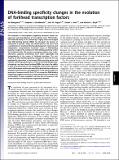DNA-binding specificity changes in the evolution of forkhead transcription factors
Author(s)
Nakagawa, So; Gisselbrecht, Stephen S.; Rogers, Julia M.; Hartl, Daniel L.; Bulyk, Martha L.
DownloadNakagawa-2013-DNA-binding specificity.pdf (997.7Kb)
PUBLISHER_POLICY
Publisher Policy
Article is made available in accordance with the publisher's policy and may be subject to US copyright law. Please refer to the publisher's site for terms of use.
Terms of use
Metadata
Show full item recordAbstract
The evolution of transcriptional regulatory networks entails the expansion and diversification of transcription factor (TF) families. The forkhead family of TFs, defined by a highly conserved winged helix DNA-binding domain (DBD), has diverged into dozens of subfamilies in animals, fungi, and related protists. We have used a combination of maximum-likelihood phylogenetic inference and independent, comprehensive functional assays of DNA-binding capacity to explore the evolution of DNA-binding specificity within the forkhead family. We present converging evidence that similar alternative sequence preferences have arisen repeatedly and independently in the course of forkhead evolution. The vast majority of DNA-binding specific city changes we observed are not explained by alterations in the known DNA-contacting amino acid residues conferring specificity for canonical forkhead binding sites. Intriguingly, we have found forkhead DBDs that retain the ability to bind very specifically to two completely distinct DNA sequence motifs.We propose an alternate specificity-determining mechanism whereby conformational rearrangements of the DBD broaden the spectrum of sequence motifs that a TF can recognize. DNA-binding bispecificity suggests a previously undescribed source of modularity and exibility in gene regulation and may play an important role in the evolution of transcriptional regulatory networks.
Date issued
2013-07Department
Harvard University--MIT Division of Health Sciences and TechnologyJournal
Proceedings of the National Academy of Sciences
Publisher
National Academy of Sciences (U.S.)
Citation
Nakagawa, S., S. S. Gisselbrecht, J. M. Rogers, D. L. Hartl, and M. L. Bulyk. “DNA-Binding Specificity Changes in the Evolution of Forkhead Transcription Factors.” Proceedings of the National Academy of Sciences 110, no. 30 (July 23, 2013): 12349–12354.
Version: Final published version
ISSN
0027-8424
1091-6490